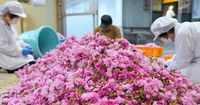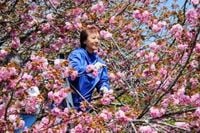As spring unfolds in Japan, the picturesque city of Qin野, located in Kanagawa Prefecture, is witnessing a vibrant celebration of nature through the peak season of salting edible yaezakura cherry blossoms. This annual tradition, which has deep cultural significance, has become a vital part of the local economy and culinary heritage.
Qin野 City is recognized as one of Japan's leading producers of edible yaezakura cherry blossoms, specifically the 'Kanzan' variety, known for its vivid pink hue and aromatic qualities. As of April 19, 2025, the salting process is in full swing, with the Chikamura district's producer group, the Chikamura Wakatakekai, working diligently to harvest and process these delicate flowers.
At the processing plant, the cherry blossoms are carefully picked when they are at 7 to 8 minutes of bloom, ensuring they possess the best color and aroma. The flowers are then salted and pickled with plum vinegar for about a month, resulting in a delicacy known as sakurazuke, or salted cherry blossoms. This year, the blossoms have been blooming slowly due to a series of cooler days and minimal rainfall, which experts predict will enhance the quality of the final product.
Kikue Kato, the 45-year-old representative of the Chikamura Wakatakekai, expressed her joy about the seasonal treat, saying, "Just by adding sakurazuke, the dining table becomes colorful and you can feel spring. I would be happy if many people could enjoy 'eatable spring'". Her enthusiasm reflects a broader sentiment in the community that celebrates not just the harvest, but the cultural significance of spring.
The sakurazuke is not only a feast for the eyes but also a sensory delight, with its pink color and subtle fragrance making it a popular choice for celebratory occasions such as weddings. The cherry blossom tea, or sakurayu, made by pouring hot water over the salted blossoms, has gained popularity for its delicate flavor and aesthetic appeal.
In recent years, the demand for sakurazuke has expanded beyond traditional uses. It is now being incorporated into various culinary creations, including Japanese and Western sweets as well as liqueurs, showcasing the versatility of this seasonal ingredient. This trend has provided local farmers with new opportunities to diversify their products and attract a broader customer base.
The cherry blossom harvest is a labor-intensive process. Farmers in the Chikamura district, which boasts approximately 2,500 yaezakura cherry trees, have been working tirelessly, often enlisting the help of part-time workers. On April 17, 2025, women could be seen climbing stepladders exceeding five meters, using sickles to pull branches closer and gently picking the blossoms one by one by hand. This meticulous approach ensures that only the finest flowers are selected for processing.
One of the local farmers, Takayuki Ogino, 79, who has been involved in this annual ritual for many years, shared his sentiments about the harvest. "I look forward to seeing the flowers once a year," he remarked, emphasizing the deep connection between the community and the natural beauty of the cherry blossoms.
The scene in Qin野 is not just about harvesting flowers; it is a vibrant tapestry of community spirit and cultural pride. The local farmers, along with their families and part-time workers, come together to celebrate the arrival of spring, sharing stories and laughter amid the blossoming trees. This collective effort is a testament to the importance of tradition and the joy of seasonal harvests.
As the year progresses, the salted cherry blossoms will find their way into homes and celebrations, bringing with them the essence of spring. The popularity of sakurazuke and sakurayu continues to grow, reflecting a renewed appreciation for traditional Japanese foods and the beauty of seasonal ingredients.
In a world where culinary trends often shift rapidly, the enduring appeal of sakurazuke serves as a reminder of the simple pleasures found in nature and the rich cultural heritage that accompanies seasonal celebrations. As the blossoms are harvested and processed, they not only contribute to the local economy but also help preserve a tradition that connects generations.
With the cherry blossom season in full swing, the community of Qin野 looks forward to sharing its edible treasures with the world. The vibrant colors and delicate flavors of sakurazuke are set to grace dining tables far and wide, inviting everyone to partake in the joy of spring.


